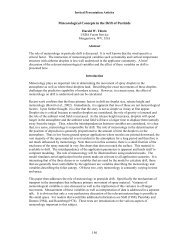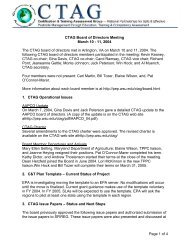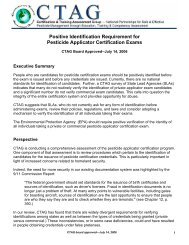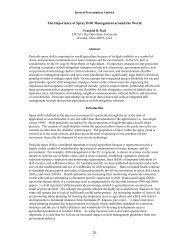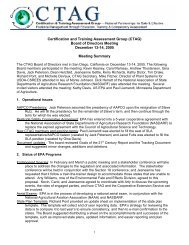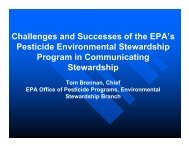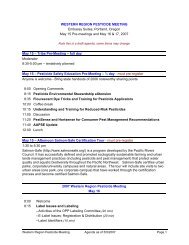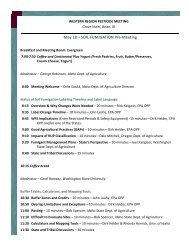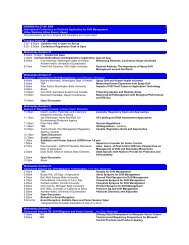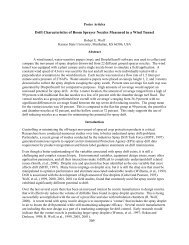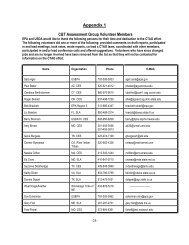PDF file - WSU Pesticide Safety Education Program
PDF file - WSU Pesticide Safety Education Program
PDF file - WSU Pesticide Safety Education Program
You also want an ePaper? Increase the reach of your titles
YUMPU automatically turns print PDFs into web optimized ePapers that Google loves.
Progress Report of the Certification & Training Assessment Group<br />
January 2002<br />
Introduction to the Certification & Training <strong>Program</strong><br />
Protecting the public and the environment through the safe and effective use of<br />
pesticides is the underlying purpose of the pesticide applicator certification and training<br />
(C&T) program. With the 1972 amendments to the Federal Insecticide, Fungicide,<br />
Rodenticide Act (FIFRA), the U.S. Environmental Protection Agency (EPA) was given<br />
the authority to restrict the use of pesticides used by certified applicators (or under their<br />
supervision). The determination of competency was delegated to pesticide state lead<br />
agencies (SLAs). <strong>Pesticide</strong> applicator training was delegated primarily to state<br />
cooperative extension service (CES) and is also performed by other entities.<br />
There are approximately 1.2 million applicators in the U.S. who have received<br />
certification to use Restricted Use <strong>Pesticide</strong>s (RUPs) on farms by air and ground<br />
equipment, in greenhouses, nurseries, golf courses, industrial plants, food production<br />
facilities, hospitals, homes, restaurants, businesses --- just to name a few. Additionally,<br />
many states require certification to use General Use or Unclassified pesticides in<br />
specialized areas. Since the early 1970s, the reality of the national C&T program has<br />
evolved to address such issues as: the need for specialized chemical-specific training,<br />
the protection of sensitive populations, increased public concern over pesticide use,<br />
agricultural/urban interface, a growing Spanish-speaking applicator workforce and<br />
pesticide use in schools.<br />
Establishment of the Certification & Training Assessment Group<br />
History<br />
The Certification & Training Assessment Group (CTAG) is a consortium of professionals<br />
to promote the safe and effective use of pesticides through education, testing and<br />
licensing, and enforcement. CTAG was formed in 1997 based on a request by the<br />
American Association of <strong>Pesticide</strong> <strong>Safety</strong> Educators (AAPSE) to undertake an in-depth<br />
study of the pesticide applicator C&T program. The mission of the group was to look at<br />
where the program had been, where it should go, determine the needs, develop a<br />
consensus for change and explore changes.<br />
The original CTAG consisted of a body of directors and four teams in the following<br />
program areas: content, infrastructure and delivery, evaluation and funding. After<br />
collecting information from SLA and CES on their programs, each team developed<br />
goals and recommendations in each area. The goals were: 1) reduce the risks to the<br />
public from pesticide use; 2) provide high quality pesticide education and safety training<br />
programs; 3) maintain the consistency, integrity and validity of the certification and<br />
recertification programs and processes; 4) ensure that adequate and equitable funding<br />
Page 1 of 5
is available to pesticide safety education, training and certification programs and 5)<br />
improve the efficiency of program organization and operations.<br />
A January 1999 draft report entitled “<strong>Pesticide</strong> <strong>Safety</strong> for the 21 st Century — The<br />
Findings and Proposals of the Certification & Training Assessment Group” was<br />
distributed for stakeholder review and comment. Comments were received from SLA<br />
certification managers, CES pesticide applicator training coordinators, state pest control<br />
associations, private training companies, state farm bureaus, state agri-business<br />
associations, chemical companies, agricultural retailers, agricultural aviators, railroad<br />
companies, nurseries, state berry growers, and Canada’s Pest Management Regulatory<br />
Agency (PMRA). Proposals were also discussed during the 1999 National <strong>Pesticide</strong><br />
Applicator Training and Certification Workshop, a 1999 <strong>Pesticide</strong> Regulatory <strong>Education</strong><br />
<strong>Program</strong> (PREP) course, and AAPCO/SFIREG and AAPSE meetings.<br />
New CTAG Board in 2001<br />
In August 2001, representatives from EPA, USDA, SLA and CES came together to<br />
review the CTAG effort. As a result of the meeting, CTAG was restructured thereby<br />
creating an official CTAG Board. Board members, including chairs and vice chairs,<br />
serve overlapping two and three year terms. It was also determined that CTAG<br />
workgroups would be established by the Board, as needed, to work on specific tasks. A<br />
CTAG charter was developed to formalize the roles and responsibilities of the CTAG<br />
Board. This group will: determine the current status and future direction of the program;<br />
create and coordinate workgroups, provide updates on accomplishments, and maintain<br />
a communications network with partners. Two workgroups were formed to focus<br />
activities on specific projects. The charge of the first workgroup is to determine the<br />
components of a C&T plan that meet the requirements of FIFRA and the elements of a<br />
C&T program that go beyond FIFRA requirements. The second workgroup is tasked<br />
with looking at how the pesticide handler portion of the WPS program can be<br />
incorporated into the current C&T program, as well as to provide EPA with a plan for a<br />
comprehensive pesticide safety program, for all persons who sell, mix, load, apply or<br />
recommend the use of pesticides, that will demonstrate competency, mitigate risk and<br />
improve pesticide security through appropriate education, training and testing. For<br />
more information, refer to the CTAG web page http://pep.wsu.edu/ctag which is under<br />
development by Carol Ramsay.<br />
Activities and Accomplishments to Date<br />
Exam Development<br />
Several activities related to exam development were carried-out in support of Goal 3 -<br />
maintain the consistency, integrity and validity of the certification and recertification<br />
programs and processes.<br />
Page 2 of 5
---Software Assessment<br />
In 2000, a CTAG Technical Review Committee provided their evaluation of<br />
commercially available Certification Exam Development Software to the states, tribes<br />
and territories. Each product was evaluated on: compatibility with equipment, capacity<br />
to store large item banks, user-friendly, use on networks, scoring and grading<br />
capabilities, cost, security, graphics, technical support and ability to scramble questions.<br />
Committee members were: Carl Rew (IN.), Carl Martin (AZ.), Randy Rivera (TX.), John<br />
Snodgrass (TX.), Gary Fish (ME.) and Jeanne Heying (EPA). Copies of the evaluation<br />
are available through Jeanne Heying (telephone 703-305-7666.)<br />
---Workshops/Sessions on Exam Development Process<br />
EPA sponsored two workshops for SLA and CES partners on "Creating a Professionally<br />
Sound and Legally Defensible <strong>Pesticide</strong> Credentialing Exam." The three day<br />
workshops were held in April 1999 and May 2000 and focused on the process used to<br />
develop a pesticide applicator exam that will give results that are reliable, consistent<br />
over time, valid and legally defensible. Representatives (at least one state regulatory<br />
and/or pesticide educator) of 42 states, 3 territories, Puerto Rico, and the District of<br />
Columbia, EPA Regions (7 & 8) and USDA participated in the two workshops. Carl<br />
Rew (IN.) was instrumental in the planning of, and instruction during, the workshops.<br />
---Core Exam Project:<br />
EPA and Canada’s PMRA are in the process of collaborating on a pesticide applicator<br />
core exam project. The outcome of the project will be a professionally developed exam<br />
of core knowledge principals for all first time candidates to become pesticide<br />
applicators. A committee of pesticide applicators and volunteers have approved a job<br />
analysis and written “items” or questions. Apart from the exam committee, items were<br />
written with the help of: Colleen Hudak/N.C., Carl Martin/AZ., Paul Baker/AZ., Sherman<br />
Takatori/ID., Ivan Sanderson/UT., Richard Beard/UT., Diana Roll/OH., Ruth<br />
Marston/MN., Derrick Lastinger/GA., Jessica Dewey/USDA-APHIS and from Canada -<br />
Terry Waddell, Susan Kelner and Sandra Shiels. Lead agencies and provincial<br />
governments are in the process of field testing items. Field testing is being conducted<br />
with the help of the following lead agencies in the U.S.: Gina Davis/MI., Liz Braxton and<br />
Norm Nesheim/FL., Sherman Takatori/N.D., Mac Takeda/CA., Randy Rivera and John<br />
Snodgrass/TX., Diana Roll/OH., Rick Hansen and Ruth Marston/MN., Dave Scott/PA.,<br />
Andrew Thostensen/N.D., Linda Schmidt/CT., Sandy Wells/OK., John Scott/CO.,<br />
Derrick Lastinger/GA., Jeff Goode/AR., Ivan Sanderson/UT., Gerald Kirbach/IL.<br />
Completed core exams are expected to be available to lead agencies and provincial<br />
governments in late 2002. Copies of the job analysis are available through Jeanne<br />
Heying/EPA (telephone 703-305-7666.)<br />
Cooperation<br />
---<strong>Pesticide</strong> <strong>Safety</strong> <strong>Education</strong> Center<br />
One of the CTAG proposals was to enhance pesticide safety education in part by<br />
strengthening the skills of pesticide safety trainers. In 2001, two pilot <strong>Pesticide</strong> <strong>Safety</strong><br />
<strong>Education</strong> Center (PSEC) courses were held for county agents and field inspectors.<br />
Page 3 of 5
The courses focused mainly on how to engage the audience and use hands-on<br />
education tools. The course was funded by the North Carolina Environmental Trust<br />
Fund and was attended by representatives from Florida, Louisiana, North Carolina,<br />
South Carolina and Virginia. Additional courses are planned for March and October<br />
2002. This project was made possible with the help of: Barry Brennan/HI., Julie Haigler<br />
and Colleen Hudak/N.C., Wayne Buhler and Bob McRracken/N.C., Bob Bellinger/S.C.,<br />
Natalia Clifton/MA., Mary Grodner/LA., Pat Hipkins and Mike Weaver/VA., Win<br />
Hock/PA., Norm Nesheim/FL., Pat O’Connor-Marer/CA., Sherman Takatori/ID., Ed<br />
Vitzthum/NE., Melanie Zavala/CA, Kerry Richards/PA., Monte Johnson/USDA, John<br />
Impson/USDA (retired) and EPA - Jeanne Heying, Richard Pont, Kevin Keaney and<br />
EPA Region 4.<br />
---Web Site on <strong>Education</strong>al Resources:<br />
Resource sharing among educators and regulators saves monetary resources<br />
expended on development and delivery. During 2001, a new web site was launched as<br />
a sharing platform for educators and regulators. The web site, http://pep.wsu.edu/psp<br />
lists materials developed or being drafted, format, dates and contact information. In<br />
order to get the most out of this resource, educators and regulators are asked to keep<br />
the web site current by continuously entering information on resources developed. If<br />
you qualify and don’t already have a login password, contact Jeanne Heying at EPA.<br />
Credit goes to Carol Ramsay/WA. for making it happen.<br />
---Workshops for Office of <strong>Pesticide</strong> <strong>Program</strong>s (OPP):<br />
EPA/OPP decisions on the classification or reclassification of pesticide uses impact<br />
pesticide safety education and regulatory programs. To improve EPA’s understanding<br />
of these ramifications, lead agencies and pesticide safety educators have voluntarily<br />
provided their time to interact with OPP staff. Workshops were held in 2000, 2001 and<br />
expect to be held again in 2002. Presenters have included: Ed Crow/MD., Rick<br />
Hansen/MN., Carol Ramsay/WA., Randy Rivera/TX., Suzanne Deatherage/TX., Larry<br />
Olsen/MI., Drew Martin/IN. and Fred Whitford/IN.<br />
---PREP Course:<br />
<strong>Pesticide</strong> Regulatory <strong>Education</strong> <strong>Program</strong>s (PREP) are courses designed to provide<br />
practical, up-to-date information on technical, policy and management related issues for<br />
state, tribal, territorial and federal partners. The goals of this national program are to<br />
strengthen partner capabilities to address current and evolving issues and continue to<br />
improve cooperation among partners. Planning is now underway for an April 2002<br />
PREP course on CTAG activities. For more information on PREP, consult:<br />
http://www.prep-gov.net<br />
---USDA Efforts:<br />
Monte Johnson, USDA’s National <strong>Program</strong> Leader, renamed the program from<br />
<strong>Pesticide</strong> Applicator Training (PAT) to <strong>Pesticide</strong> <strong>Safety</strong> <strong>Education</strong> <strong>Program</strong> (PSEP) to<br />
reflect that the coordinators and staff in the Cooperative Extension Service at Land<br />
Grant Universities serve not only pesticide applicators, but the public, master gardeners,<br />
technicians, professional associations and others. The Performance Planning and<br />
Page 4 of 5
Reporting System (PPRS) is a web-based reporting system for the PSEP coordinators<br />
that was initiated in 2001. The Plans of Work and Annual Reports from PPRS will be<br />
used to justify funding for the program and provide data to enhance the program’s<br />
visibility and credibility. Also, USDA is forming committees to review PPRS and<br />
address possible changes to the funding formula. For more information, contact Monte<br />
(telephone 202-401-1121) or visit:<br />
http://www.reeusda.gov/pas/programs/pat/coverpas.htm<br />
CTAG 2001<br />
---(#1) Workgroup on C&T Plans:<br />
The State Plan CTAG workgroup, led by Carol Ramsay/WA. and Debborah Danford/TX.<br />
met in December 2001 to review and continue progress on tasks related to improving<br />
FIFRA C&T programs. Substantial progress was made on the development of a draft<br />
C&T state plan template which will facilitate the collection, maintenance and review of<br />
required state plan components, applicator number reporting requirements, reciprocity<br />
agreements and access to additional program information. The template will be further<br />
developed with the help of program partners during the April 2002 PREP course.<br />
Three white (or “issue”) papers were developed to address current impediments in<br />
FIFRA and its corresponding rules (40 CFR Part 171). These issues include: 1)<br />
Requiring Minimum Age Requirements for Approval of State Certification <strong>Program</strong>s; 2)<br />
Requiring Written Examinations for Approval of State Certification <strong>Program</strong>s and 3)<br />
Eliminating 50/50 Grant Funding Match Requirements for C & T <strong>Program</strong>s.<br />
---(#2) Workgroup on <strong>Program</strong> Integration:<br />
The second workgroup, led by Carl Martin/AZ. and Pat O’Connor-Marer/CA. met<br />
January 15 - 16, 2002 in Alexandria, Virginia. The workgroup is now drafting proposals<br />
on measures that could be taken throughout the lifetime of a pesticide product that<br />
would increase security of pesticides and application equipment.<br />
Future Efforts<br />
As is demonstrated in the 1999 “<strong>Pesticide</strong> <strong>Safety</strong> for the 21 st Century — The Findings<br />
and Proposals of the Certification & Training Assessment Group,” the universe of<br />
issues, concerns and possibilities in the C&T program continue to change and evolve<br />
over time. While the fundamental needs of the program are being addressed, new<br />
areas to be addressed are continually rising to the top and the “wish list” always<br />
remains. Fortunately, there are many lead agency and safety education partners willing<br />
to contribute time, energy and enthusiasm for the good of the program and its role in our<br />
society.<br />
Page 5 of 5



